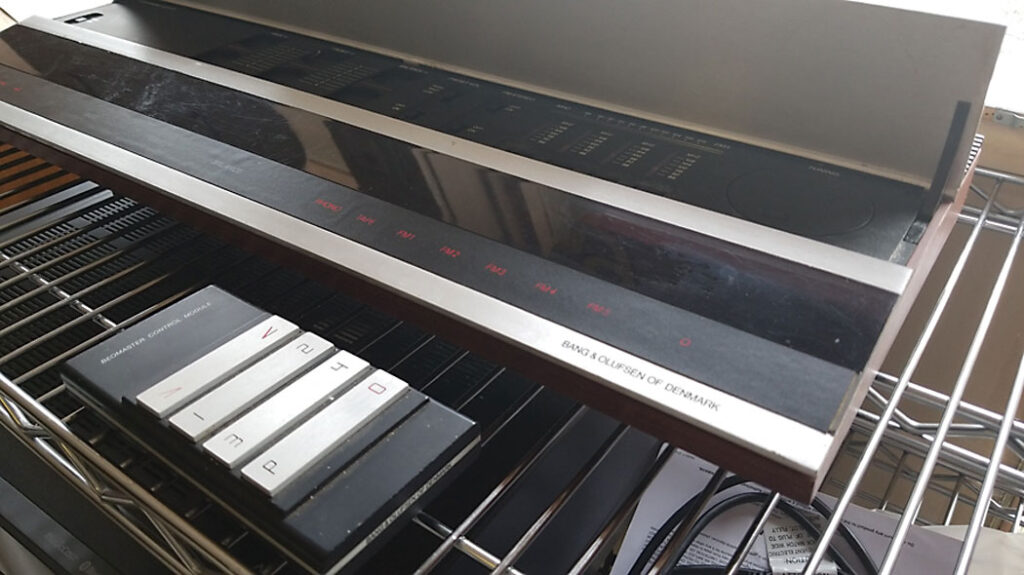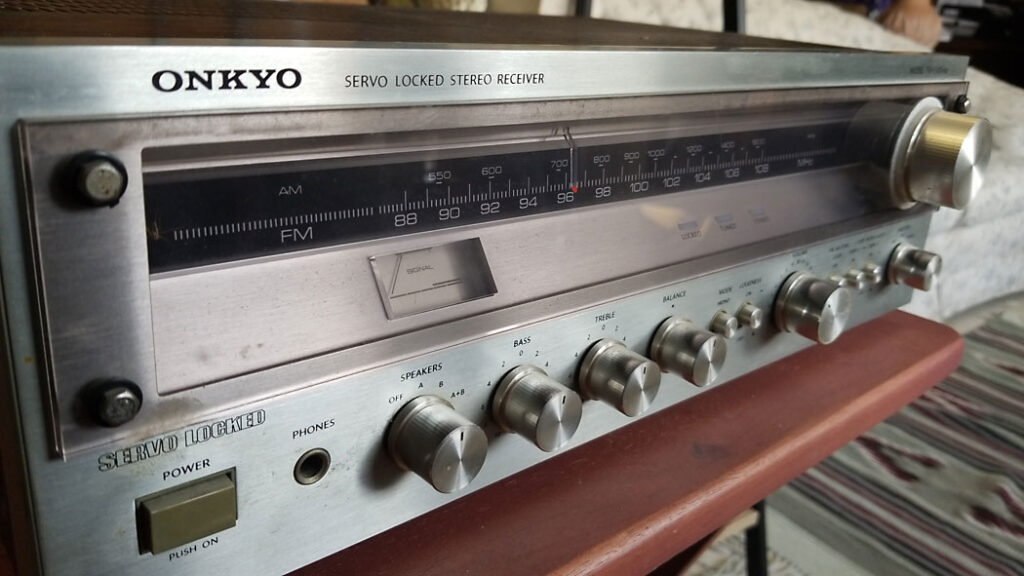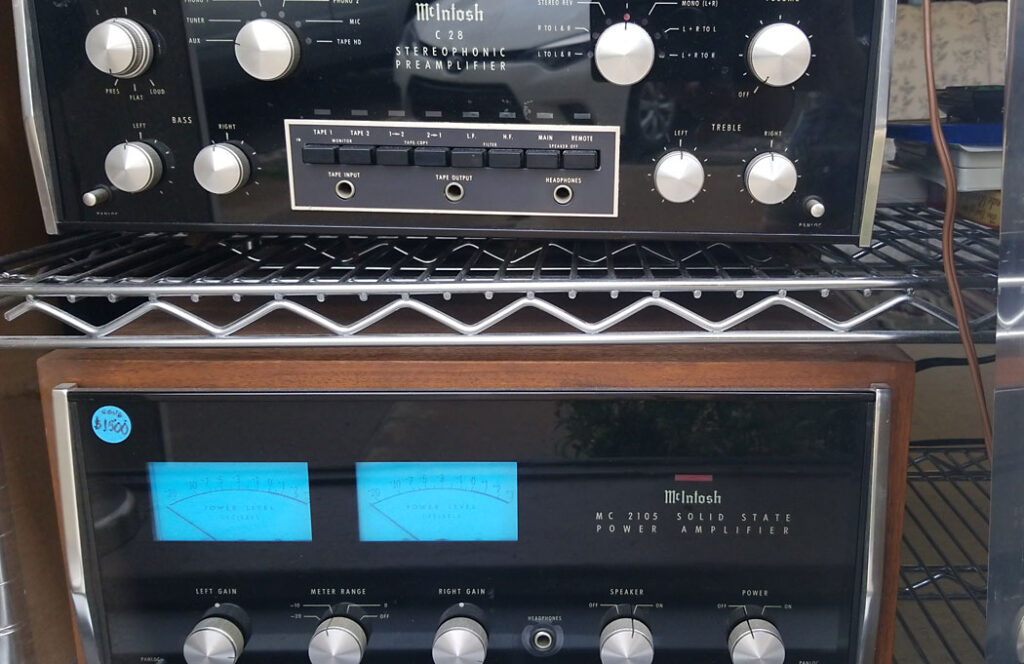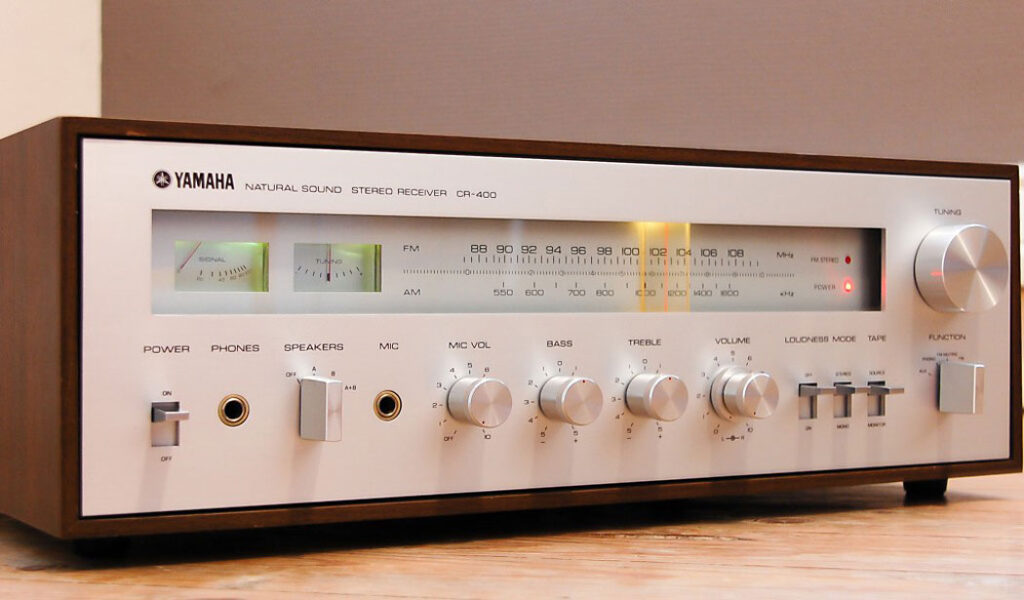
Vintage audio equipment can be fun to own. Just know why you want it, and don’t expect too much.
Recently, I was gifted one of my favorite old pieces of audio equipment from 1979—the Bang & Olufsen Beomaster 2400 receiver. It was, without a doubt, the easiest-to-use stereo receiver of all! Five FM presets, each with its own touch button, turned the receiver on at a predetermined volume when you selected it. That was true for the phono and tape buttons as well. Imagine—one touch to music! It also included a new remote control that had those same buttons, plus volume up and down. That’s all. To top it off, the receiver was beautiful, a low-slung Scandinavian design with rosewood and aluminum accents, and an access door that closed verrry slowly for the sake of coolness. The B & O electronics were so stunning, they found their way into the collections of the Museum of Modern Art and the Smithsonian.
I admit, life was simpler then—so much less to hook up. CDs were two years away. No computers, no streaming. My plan is to secretly modernize my Beo 2400 by hooking it to a hidden box that will turn the TV’s digital out to analog, so I can play all the TV’s smart features and a Blu-ray through the tape input. With retro style!
Do I expect it to sound as good as anything current? No. But then there’s that door that closes soooo slowly. And I have some very impressive new speakers that will make it sing.
Receiving this gift made me think about what makes an old piece of audio gear into a classic. Lucky for you, I was around when this Flintstone-era gear was new! In the case of B & O, their design element carried the day. This receiver still looks like new technology 41 years later!

The most sought-after vintage audio items today are the big stereo receivers from the 1970s: Kenwood, Pioneer, Onkyo, Marantz, Sansui, and Sony. Their huge tuner dials, hefty builds, and cool metal and glass faceplates can look very impressive when cleaned up. Are they worth the trouble in terms of their sound performance? Mostly not. They’re more like owning a ’57 Chevy. Performance isn’t the only reason for pride of ownership.
Most early transistor amp designs had some timing issues that were fatiguing to the ear, if you compare them with today’s better components. Their background hiss was also higher. After all, records were our quietest source then, so the need for a superquiet background wasn’t important until CDs came out in the early ’80s.
These receivers were built to last, and most of the better names were quite reliable. Expect some age-related service issues, however, such as noisy volume and tone controls, and tape monitor and speaker switches that can lose one channel. Most of the time, a vintage receiver will be quite useful when the controls are cleaned up, but occasionally internal parts like transformers and capacitors can dry out. These are usually fixable, but it may develop into a costly resurrection.

When I got into the stereo business in 1973, the God of Audio was McIntosh Labs. For many, it still is. Built to last forever, excellent customer service, and glowing glass faceplates with big blue power meters. These were the amps that powered Woodstock! Who could have guessed that they would now sell used for more than their original new price?
They’ve never been inexpensive, so I was always more likely to recommend a well-built receiver over expensive separates, so my clients wouldn’t have to wait to get into better speakers. (For those of you unfamiliar with the terms, separates are electronics that only have one function per box. A receiver has three functions in one box: preamplifier, power amplifier, and tuner. The “preamplifier” controls your choice of inputs, tone controls, and volume, and prepares your sources to be playable through your “power amplifier.” The power amplifier has the input from the preamp, the speaker terminals, and the guts to make your speakers move. The “tuner” is the AM/FM radio part. All three of these parts in one box are called a “receiver.”)

My favorite receiver line, musically, showed up in 1974. Yamaha’s CEO was a lover of McIntosh separate components, and he decided to have Yamaha make their receivers sound just as sophisticated.
We loved their build, but Yamaha cost more per watt of power than any of the other receivers. Then one day, a college student showed up at the store to return an almost new, very popular 70-watts-per-channel Pioneer receiver to trade it in for Yamaha’s smallest receiver with only 15 watts per channel. We had to know why. I’ll paraphrase what he told me so long ago:
“My roommate came home with the 15-watts-per-channel Yamaha, and I gave him a hard time. ‘Sure, it’s pretty,’ I told him. ‘But you have Large Advent speakers that are pretty power hungry. You made a big mistake.’
“Then we made a bet. Between us, we had two pairs of those Advent speakers, and we played them separately and together, on all types of music. All weekend. No matter what we did, Yamaha always won the contest. Clearer. Even louder! I lost the bet. So I’m trading in my Pioneer for the littlest Yamaha.”
I sold tons of Yamaha after that. It gave me the ability to sell those better speakers with worthy electronics. My first “speaker-heavy” systems.
Yamaha had about a ten-year run before the power of their receivers was compromised by marketing other features, but what magical equipment they had created. Fortunately, not too many years ago, they decided to re-adopt their former approach to sonic excellence, so they’re back to being my favorite receiver line. Of course, now it would take a whole article to list what they can do!
Other standout receiver brands of that era were Harman Kardon and NAD. I expect that these three classics still give new receivers a run for their money.
Not everyone should buy used, and even fewer should try to rebuild. However, if you find a vintage piece of audio gear in great condition, try it out. It will certainly give you more for the money than anything the big box stores could offer. You’ll own a piece of equipment from audio’s “Golden Years.” And when it’s time to move up, you’ll sell it for most of what you paid—like a savings account toward your “dream system.”
Paul welcomes your feedback at paul@paulsquillo.com. He’d love to hear from you. Or call him to set up a listen: (641) 455-6727. Paul is a trumpet player, an audio-video specialist, and CEO of Golden Ears, Inc., in Fairfield, Iowa.
